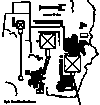
 John A.R. Legon, B.Sc., took his degree in Applied Physics at the University of Sussex in 1971. He has studied the archaeology of the Pyramids for the past five years, and visited Egypt in 1975. A member of the Egypt Exploration Society.THE PLAN OF THE GIZA PYRAMIDSby John A.R. LegonWhen approaching, from the Nile Valley, the plateau of rock upon which stand the three Pyramids of Giza, the visitor may be surprised to find that the scene is dominated, not by the largest or Great Pyramid, but by the Second Pyramid. Although the Great Pyramid is considered to have been built first, it occupies neither the highest ground nor the most central position, but instead is situated on the lower part of the plateau, very close to the northern cliff. This position required that the causeway to the temple on the east, or valley side, be supported by a massive ramp in ascending the cliff, to a height of nearly 100 feet. If the builders of the Great Pyramid had the entire plateau at their disposal, why did they not choose the more favorable setting of the central or Second Pyramid - the causeway of which ascends a natural incline? While the site chosen for the Second Pyramid gave an advantage in height over the base of the Great Pyramid, of some 30 feet, it seems strange that use was not made of the still higher and more level ground, further to the northwest. Instead, the Pyramid was built where the natural rock-surface sloped downwards considerably towards the southeast, so that the site had to be artificially leveled. This was achieved by the cutting away of a deep escarpment along the north and west sides, while a megalithic foundation platform was built to support the southeast corner. Similarly in placing the Third Pyramid, the northeast corner and the temple on the east side required to be supported, where the natural rock fell away, by a massive substructure to a height of up to 15 feet. Why was such work undertaken when use could have been made of more level ground, further to the west? These details suggest that there was some factor, more important than considerations of
architectural setting or ease of construction, which determined where the three Pyramids
were positioned. Another indication is given by the very regular arrangement of these
Pyramids on the plateau (fig. 1). In the year 1880, a young surveyor from England arrived in Egypt with the intention of making a precise survey of the Great Pyramid. His aim was to establish the accuracy of - although subsequently to disprove - the theory that the dimensions were in effect a revelation expressed in terms of a "pyramid-inch", corresponding closely to the British unit. Not content to confine his attention to the Great Pyramid alone this surveyor, W.M. Flinders Petrie, extended his triangulation of the plateau to include the Second and Third Pyramids, besides other features - a task that required the fixing of over fifty stations, to an accuracy within 0.1 inch for the main points. This survey, which laid the foundations for Petrie's long career in Egyptology, also involved numerous excavations to uncover the original bases of the three Pyramids. In his published work, Petrie recorded the dimensions and orientations of the three Pyramids together with the axial distances separating the centres of their bases; also the co-ordinates of survey, from which a full analysis can be made. These dimensions reveal an underlying plan, remarkable both for its simplicity and the accuracy with which it was laid out. With reference to the Royal Egyptian Cubit, of exactly the value determined by Petrie from measurements in the Great Pyramid - 20.620 inches - the mean distances were set in a horizontal plane within two or three inches of the design, which briefly is as follows: The Great Pyramid possesses the "pi proportion", whereby the height of 280 cubits is to the perimeter of the base of 1760 cubits, as the radius of a circle is to its circumference (for pi = 22/7). The sides of the base thus measure 440 cubits, with an adjustment in three sides evidently to give the more accurate mean side 280 x pi/2 = 439.8...cubits.
Similarly along the east-west axis of the plan, the west side of the Second Pyramid is
placed 2, 1/2 x 250 = 625 cubits west from the west side of the Great Pyramid. In
practice, for reasons given below, one cubit was subtracted from the dimension 625 and
added to the dimension 1100 (fig. 3),and so the
sides of base of the Second Pyramid measure 1101 - 250 - 440 = 411 cubits. This scheme (fig. 4) As shown in figure 4, the radius of the circle 353.5 is made the axial distance west from the west side of the Second Pyramid to the west side of the Third Pyramid. This distance is exactly one-quarter of the nominal overall dimension on the same axis, 1000 root 2 or 1414 cubits, which became, however, 353.5 + 624 + 440 = 1417.5 cubits. On the north-south axis, the line of the south side of the Second Pyramid being tangent to the circle, it is 353.5 + 555/2 root 2 = 631 cubits north from the south side of the Third Pyramid, so that the overall dimension became 631 + 1101 = 1732 or exactly 1000 root 3 cubits. Thus the adjustment of one cubit between the dimensions 624 and 1101, made both overall dimensions more accurate. That there were other factors involved in the ground plan, is indicated by the approximate alignment of the N.W. corner of the Great Pyramid with the S.W. corners of the Second and Third Pyramids. In addition, the Third Pyramid has nearly 1/3 degree clockwise rotation relative to the axes of the plan, introducing whole numbers of tens of cubits in dimensions northwards from both the N.E. and N.W. corners, which would otherwise have been greater or less by 0.5 cubit. In conclusion, we should note that while this plan accounts for the siting of the Giza Pyramids, it also places a question on the purpose of their construction. Although there can be little doubt as to the use of the three edifices as royal tombs during the IVth Dynasty, c. 2600 B.C., it seems unlikely that those kings would either have conceived of the plan or accepted its requirements - especially as regards the small dimensions for the Third Pyramid. At Giza the monuments are of a very different character to the funerary structures of the IIIrd and VI Dynasties at Sakkara and elsewhere, so that taking the present findings together with the remarkable arrangements of passages in the three Pyramids, it does not appear that the "tombic" theory provides a wholly satisfactory explanation. Published by "Archaeological Reports", Vol.10, May 1979, No.1
|
| Home | Foreword
| Calculations | Dimensions
| Coordinates |JL Pamphlet |
Build your own! |
|



